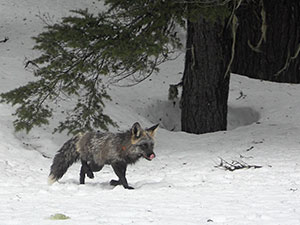Fish Report for 5-5-2017
First Sierra Nevada red fox captured, radio-collared in Oregon
by ODFW
5-5-2017
Website
A Sierra Nevada red fox (SNRF) was captured and radio-collared in Deschutes County this week, a first for Oregon wildlife biologists researching this rare sub-species of red fox.
The Oregon Department of Fish and Wildlife and Tim Hiller of the Wildlife Ecology Institute have continued a SNRF study that began in 2012 and are now in the phase to capture and radio-collar the foxes in the Oregon Cascades. The original study confirmed SNRF presence in the Oregon Cascades and was partially responsible for the U.S. Fish and Wildlife Service’s decision not to list the species in Oregon.
Project leaders Hiller and ODFW wildlife technician Jack Vaughn hope to capture and radio-collar nine more SNRF by the end of June 2018. Capture activities will continue for the next few weeks, and resume again later this fall when success rates are higher than other seasons.
“We use specialized cage traps originally designed for bobcats. It’s a challenge using these during winter, especially this year with the heavy snowfall, so we were very happy to capture this SNRF female,” Vaughn said.
The collars will be active for one year and Vaughn will monitor them from the ground.
SNRF is an Oregon Conservation Strategy Species. Strategy Species include those with small, declining, or unknown population levels that could be at risk and may be in need of conservation.
Within the Strategy, ODFW identified data gaps associated with this rare montane (mountain) fox, including assessing population dynamics, collecting genetic information, understanding seasonal habitat use, and evaluating competition from coyotes. The current study aims to fill some of those data gaps.
“Information collected from SNRF in Oregon has never before occurred, and will not only benefit conservation and management in Oregon, but could also be critical for efforts in California,” stated Hiller. “Radio-collared foxes could give us information on habitat use, denning activities, foraging behavior, seasonal elevational changes and sources of mortality.” Hiller said six SNRF have been captured in past and present studies in California.
SNRF is found only in high-elevation meadows and forests of the Oregon Cascades south into northern California, and in the Sierra Nevada of California. The latter population is believed to have less than 50 individuals in total, whereas the Oregon Cascades may hold more foxes, but probably in fragmented areas. In fact, Hiller said past and ongoing research in Oregon suggests that SNRF, while still rare, may be more widespread than originally thought.
The individual captured in Deschutes County early this week was an adult female and the “cross” color phase (see photo). Other color phases include silver (black) and the more familiar red. SNRF generally are smaller than other red foxes and average about eight pounds.
Field research on SNRF in Oregon was first initiated during 2012 by ODFW with assistance from U.S. Forest Service, and included camera surveys and hair and scat collection for genetic analyses. This study, which continues to collect information on SNRF, confirmed their presence in the Oregon Cascades, specifically in the Mt. Jefferson, Mt. Washington, and Three Sisters Wilderness Areas. Genetic samples are sent to UC Davis for analysis. Additional research findings from this phase of the project will be coming out in the near future.
Funding for this project comes from ODFW, the Pittman-Robertson Act and the U.S. Fish and Wildlife Service. Other project cooperators and funders include Wildlife Ecology Institute, U.S. Forest Service, UC Davis, The High Desert Museum, Cascades Carnivore Project, Oregon Wildlife Foundation, and Oregon Zoo Foundation.
Photos
More Reports
Drones deployed the first time in Oregon elk surveys
5-5-2017
From their vantage point high atop the Oregon Coast Range, Oregon Department of Fish and Wildlife biologist Herman Biederbeck and...... Read More
ODFW Weekly Recreational Report

5-4-2017
Some of the best trout fishing of the year Takes place in the spring. Water conditions are good, and lakes, ponds...... Read More

Website Hosting and Design provided by TECK.net
